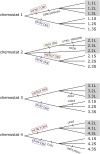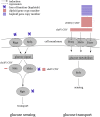Heterozygote Advantage Is a Common Outcome of Adaptation in Saccharomyces cerevisiae
- PMID: 27194750
- PMCID: PMC4937471
- DOI: 10.1534/genetics.115.185165
Heterozygote Advantage Is a Common Outcome of Adaptation in Saccharomyces cerevisiae
Abstract
Adaptation in diploids is predicted to proceed via mutations that are at least partially dominant in fitness. Recently, we argued that many adaptive mutations might also be commonly overdominant in fitness. Natural (directional) selection acting on overdominant mutations should drive them into the population but then, instead of bringing them to fixation, should maintain them as balanced polymorphisms via heterozygote advantage. If true, this would make adaptive evolution in sexual diploids differ drastically from that of haploids. The validity of this prediction has not yet been tested experimentally. Here, we performed four replicate evolutionary experiments with diploid yeast populations (Saccharomyces cerevisiae) growing in glucose-limited continuous cultures. We sequenced 24 evolved clones and identified initial adaptive mutations in all four chemostats. The first adaptive mutations in all four chemostats were three copy number variations, all of which proved to be overdominant in fitness. The fact that fitness overdominant mutations were always the first step in independent adaptive walks supports the prediction that heterozygote advantage can arise as a common outcome of directional selection in diploids and demonstrates that overdominance of de novo adaptive mutations in diploids is not rare.
Keywords: adaptation; diploid; experimental evolution; heterozygote advantage.
Copyright © 2016 by the Genetics Society of America.
Figures



Similar articles
-
Overdominant and partially dominant mutations drive clonal adaptation in diploid Saccharomyces cerevisiae.Genetics. 2022 May 31;221(2):iyac061. doi: 10.1093/genetics/iyac061. Genetics. 2022. PMID: 35435209 Free PMC article.
-
Haploids adapt faster than diploids across a range of environments.J Evol Biol. 2011 Mar;24(3):531-40. doi: 10.1111/j.1420-9101.2010.02188.x. Epub 2010 Dec 16. J Evol Biol. 2011. PMID: 21159002
-
Heterozygote advantage as a natural consequence of adaptation in diploids.Proc Natl Acad Sci U S A. 2011 Dec 20;108(51):20666-71. doi: 10.1073/pnas.1114573108. Epub 2011 Dec 5. Proc Natl Acad Sci U S A. 2011. PMID: 22143780 Free PMC article.
-
Experimental studies on ploidy evolution in yeast.FEMS Microbiol Lett. 2004 Apr 15;233(2):187-92. doi: 10.1111/j.1574-6968.2004.tb09481.x. FEMS Microbiol Lett. 2004. PMID: 15108721 Review.
-
Genomic investigations of evolutionary dynamics and epistasis in microbial evolution experiments.Curr Opin Genet Dev. 2015 Dec;35:33-9. doi: 10.1016/j.gde.2015.08.008. Epub 2015 Sep 14. Curr Opin Genet Dev. 2015. PMID: 26370471 Free PMC article. Review.
Cited by
-
Emergence of a floral colour polymorphism by pollinator-mediated overdominance.Nat Commun. 2019 Jan 8;10(1):63. doi: 10.1038/s41467-018-07936-x. Nat Commun. 2019. PMID: 30622247 Free PMC article.
-
The Influence of Polyploidy on the Evolution of Yeast Grown in a Sub-Optimal Carbon Source.Mol Biol Evol. 2017 Oct 1;34(10):2690-2703. doi: 10.1093/molbev/msx205. Mol Biol Evol. 2017. PMID: 28957510 Free PMC article.
-
Enhancing xylose-fermentation capacity of engineered Saccharomyces cerevisiae by multistep evolutionary engineering in inhibitor-rich lignocellulose hydrolysate.FEMS Yeast Res. 2024 Jan 9;24:foae013. doi: 10.1093/femsyr/foae013. FEMS Yeast Res. 2024. PMID: 38604750 Free PMC article.
-
Heterozygote advantage can explain the extraordinary diversity of immune genes.Elife. 2024 Nov 26;13:e94587. doi: 10.7554/eLife.94587. Elife. 2024. PMID: 39589392 Free PMC article.
-
Seeking Goldilocks During Evolution of Drug Resistance.PLoS Biol. 2017 Feb 3;15(2):e2001872. doi: 10.1371/journal.pbio.2001872. eCollection 2017 Feb. PLoS Biol. 2017. PMID: 28158184 Free PMC article.
References
-
- Bevis B. J., Glick B. S., 2002. Rapidly maturing variants of the Discosoma red fluorescent protein (DsRed). Nat. Biotechnol. 20: 83–87. - PubMed
-
- Brown C. J. C., Todd K. M., Rosenzweig R. F. R., 1998. Multiple duplications of yeast hexose transport genes in response to selection in a glucose-limited environment. Mol. Biol. Evol. 15: 931–942. - PubMed
MeSH terms
Grants and funding
LinkOut - more resources
Full Text Sources
Other Literature Sources
Molecular Biology Databases

